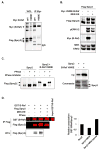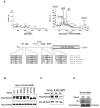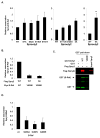Sprouty2 association with B-Raf is regulated by phosphorylation and kinase conformation
- PMID: 19690147
- PMCID: PMC2762204
- DOI: 10.1158/0008-5472.CAN-08-4447
Sprouty2 association with B-Raf is regulated by phosphorylation and kinase conformation
Abstract
Sprouty2 is a feedback regulator that controls the Ras/Raf/MEK/extracellular signal-regulated kinase mitogen-activated protein kinase (MAPK) pathway at multiple levels, one way being through direct interaction with Raf kinases. Consistent with a role as a tumor suppressor, Sprouty2 expression is often down-regulated in human cancers. However, Sprouty2 is up-regulated in some cancers, suggesting the existence of posttranscriptional mechanisms that permit evasion of Sprouty2-mediated antitumorigenic properties. We report that MAPK activation induces Sprouty2 phosphorylation on six serine residues, which reduced Sprouty2 association with wild-type B-Raf. Mutation of these six serines to nonphosphorylatable alanines increased the ability of Sprouty2 to inhibit growth factor-induced MAPK activation. Oncogenic B-Raf mutants such as B-Raf V600E did not associate with Sprouty2, but this resistance to Sprouty2 binding was not due to phosphorylation. Instead, the active kinase conformation induced by oncogenic mutation prevents Sprouty2 binding. These results reveal a dual mechanism that affects the Sprouty2/B-Raf interaction: Sprouty phosphorylation and B-Raf conformation.
Figures






Similar articles
-
C-Raf inhibits MAPK activation and transformation by B-Raf(V600E).Mol Cell. 2009 Nov 13;36(3):477-86. doi: 10.1016/j.molcel.2009.10.017. Mol Cell. 2009. PMID: 19917255
-
Tyrosine phosphorylation of Sprouty proteins regulates their ability to inhibit growth factor signaling: a dual feedback loop.Mol Biol Cell. 2004 May;15(5):2176-88. doi: 10.1091/mbc.e03-07-0503. Epub 2004 Mar 5. Mol Biol Cell. 2004. Retraction in: Mol Biol Cell. 2022 Jul 1;33(8):re3. doi: 10.1091/mbc.E03-07-0503-corr. PMID: 15004239 Free PMC article. Retracted.
-
Identification and Characterization of a B-Raf Kinase α-Helix Critical for the Activity of MEK Kinase in MAPK Signaling.Biochemistry. 2020 Dec 22;59(50):4755-4765. doi: 10.1021/acs.biochem.0c00598. Epub 2020 Dec 3. Biochemistry. 2020. PMID: 33272017 Free PMC article.
-
Targeting oncogenic Raf protein-serine/threonine kinases in human cancers.Pharmacol Res. 2018 Sep;135:239-258. doi: 10.1016/j.phrs.2018.08.013. Epub 2018 Aug 15. Pharmacol Res. 2018. PMID: 30118796 Review.
-
RAF protein-serine/threonine kinases: structure and regulation.Biochem Biophys Res Commun. 2010 Aug 27;399(3):313-7. doi: 10.1016/j.bbrc.2010.07.092. Epub 2010 Jul 30. Biochem Biophys Res Commun. 2010. PMID: 20674547 Review.
Cited by
-
Targeting the mitogen-activated protein kinase pathway: physiological feedback and drug response.Clin Cancer Res. 2010 Jul 1;16(13):3329-34. doi: 10.1158/1078-0432.CCR-09-3064. Epub 2010 May 14. Clin Cancer Res. 2010. PMID: 20472680 Free PMC article. Review.
-
Discrete cytosolic macromolecular BRAF complexes exhibit distinct activities and composition.EMBO J. 2017 Mar 1;36(5):646-663. doi: 10.15252/embj.201694732. Epub 2017 Jan 16. EMBO J. 2017. PMID: 28093501 Free PMC article.
-
Downregulation of Raf-1 kinase inhibitory protein as a sorafenib resistance mechanism in hepatocellular carcinoma cell lines.J Cancer Res Clin Oncol. 2018 Aug;144(8):1487-1501. doi: 10.1007/s00432-018-2672-y. Epub 2018 Jun 1. J Cancer Res Clin Oncol. 2018. PMID: 29858683 Free PMC article.
-
A SPRY2 mutation leading to MAPK/ERK pathway inhibition is associated with an autosomal dominant form of IgA nephropathy.Eur J Hum Genet. 2015 Dec;23(12):1673-8. doi: 10.1038/ejhg.2015.52. Epub 2015 Mar 18. Eur J Hum Genet. 2015. PMID: 25782674 Free PMC article.
-
The MEK/ERK Network as a Therapeutic Target in Human Cancer.Mol Cancer Res. 2021 Mar;19(3):361-374. doi: 10.1158/1541-7786.MCR-20-0687. Epub 2020 Nov 2. Mol Cancer Res. 2021. PMID: 33139506 Free PMC article. Review.
References
-
- Hacohen N, Kramer S, Sutherland D, Hiromi Y, Krasnow MA. sprouty encodes a novel antagonist of FGF signaling that patterns apical branching of the Drosophila airways. Cell. 1998;92:253–63. - PubMed
-
- de Maximy AA, Nakatake Y, Moncada S, Itoh N, Thiery JP, Bellusci S. Cloning and expression pattern of a mouse homologue of drosophila sprouty in the mouse embryo. Mech Dev. 1999;81:213–6. - PubMed
-
- Tefft JD, Lee M, Smith S, et al. Conserved function of mSpry-2, a murine homolog of Drosophila sprouty, which negatively modulates respiratory organogenesis. Curr Biol. 1999;9:219–22. - PubMed
-
- Minowada G, Jarvis LA, Chi CL, et al. Vertebrate Sprouty genes are induced by FGF signaling and can cause chondrodysplasia when overexpressed. Development. 1999;126:4465–75. - PubMed
-
- Kim HJ, Bar-Sagi D. Modulation of signalling by Sprouty: a developing story. Nat Rev Mol Cell Biol. 2004;5:441–50. - PubMed
Publication types
MeSH terms
Substances
Grants and funding
LinkOut - more resources
Full Text Sources
Molecular Biology Databases
Research Materials
Miscellaneous

